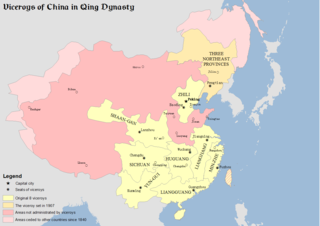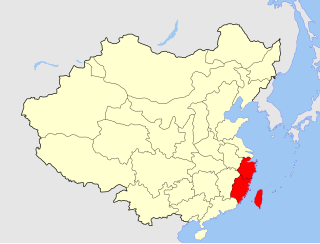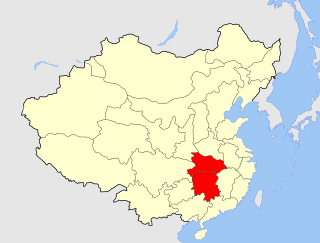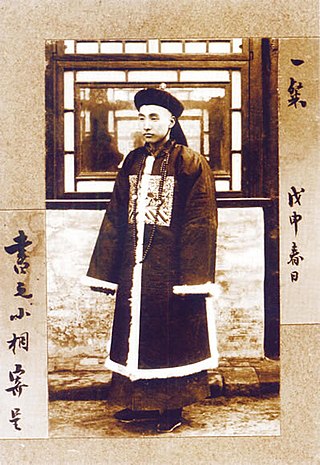
Shaanxi is a landlocked province of China. Officially part of Northwest China,it borders the province-level divisions of Shanxi,Henan (E),Hubei (SE),Chongqing (S),Sichuan (SW),Gansu (W),Ningxia (NW) and Inner Mongolia (N).
Hešeri,is a clan of Manchu nobility with Jianzhou Jurchens roots,originally hailing from the area which is now the modern Chinese provinces of Jilin and Liaoning. It was once one of the most important and powerful noble families in the early Qing dynasty in China,second only to the royal House of Aisin Gioro,to whom they were closely related by marriage.

Zongdu,usually translated as Viceroy,Head of State or Governor-General,governed one territory or more provinces of China during the Ming and Qing dynasties.
Qishan,courtesy name Jing'an,was a Mongol nobleman and official of the late Qing dynasty. He was of Khalkha Mongol and Borjigit descent,and his family was under the Plain Yellow Banner of the Manchu Eight Banners. He is best known for negotiating the Convention of Chuanbi on behalf of the Qing government with the British during the First Opium War of 1839–42.

Zhang Yi,courtesy name Bogong,was a Chinese military general and politician of the state of Shu Han during the Three Kingdoms period of China. Born in the late Eastern Han dynasty,Zhang Yi was a 10th-generation descendant of Zhang Liang. He started his career as a scribe under the warlord Liu Bei,who founded Shu later,and gradually rose to the positions of a county prefect and commandery administrator. In the early 230s,he served as an area commander tasked with maintaining the peace in Shu's southern commanderies. In 234,he led the Shu vanguard during the Battle of Wuzhang Plains against Shu's rival state Wei. From 238 to 259,Zhang Yi steadily rose through the ranks to become one of Shu's top generals. During this time,although he strongly opposed the Shu general Jiang Wei's aggressive stance towards Wei,he still accompanied Jiang Wei on his military campaigns against Wei. In 263,he surrendered to Wei forces along with the Shu emperor Liu Shan when Wei launched a large-scale invasion of Shu. In the following year,Zhang Yi was killed by mutineers during a rebellion by the Wei general Zhong Hui. Like Liao Hua and Zong Yu,Zhang was one of few officials who served the Shu-Han state throughout its entire existence.

The Viceroy of Liangguang,fully in Chinese as the Governor-General of Two Guang Provinces and Other Local Areas,in Charge of Military Affairs,Food and Wages and Governor Affairs,was one of eight regional Viceroys during the Ming and Qing dynasties of China. The Viceroy of Liangguang had jurisdiction of military,civil,and political affairs over then Guangdong Province and then Guangxi Province.

The Viceroy of Liangjiang,fully named in Chinese as the Governor-General of the Two River Provinces and Other Local Admirals,in Charge of Military Affairs,Food and Wages,Management of Rivers,and Administration on Nanhe Affairs,was one of eight regional Viceroys during the Qing dynasty. The Viceroy of Liangjiang had jurisdiction of military,civil,and political affairs over then Jiangnan Province and then Jiangxi Province. The position was set up in 1647 and abolished in 1912.

The Viceroy of Min-Zhe,fully in Chinese as the Governor-General of Min-Zhe Provinces and Other Local Areas,in Charge of Military Affairs,Food and Wages and Governor Affairs,was one of eight Viceroys during the Qing dynasty. The Viceroy of Sichuan had jurisdiction of military,civil,and political affairs over then Fujian Province,Zhejiang Province,and Taiwan Province.

Shaan–Gan–Ning Border Region,or in postal romanization Shen–Kan–Ning,commonly known by its historical sources as the Yan'an Soviet was a historical proto-state that was formed in 1937 by the Chinese Communist Party following the collapse of the Chinese Soviet Republic in agreement with the Kuomintang as a part of the Second United Front policy,substituting the former anti-Kuomintang Soviets. It existed until 1950.

The Nine Garrisons,Jiubian,or Jiuzhen,were Chinese military garrisons along the Great Wall installed by the Ming dynasty during the reign of the Hongzhi Emperor between 1487 and 1505.

The Viceroy of Huguang,fully in Chinese as the Governor-General of Hubei,Hunan and Other Local Areas,in Charge of Military Affairs,Food and Wages and Governor Affairs,was one of eight regional Viceroys during the Qing dynasty. The Viceroy of Huguang had jurisdiction of military,civil,and political affairs over then Hubei Province and then Hunan Province.

The Viceroy of Sichuan,fully in Chinese as the Governor-General of Sichuan and Other Local Areas,in Charge of Military Affairs,Food and Wages and Governor Affairs,was one of eight regional Viceroys during the Qing dynasty. The Viceroy of Sichuan had jurisdiction of military,civil,and political affairs over then Sichuan Province.

The provincial military commander was the highest military official in the Chinese provinces of the Green Standards in Qing dynasty (1644–1911). There was usually one in each province,but sometimes there were two in a province which one in charge of the army and another on in charge of the navy. Under the jurisdiction of the provincial governor and sometimes a governor-general (總督),he was in charge of the Chinese military forces known as the Green Standards,but had no control over the Eight Banners. The provincial military commander is also known as provincial commander-in-chief and general-in-chief.
A xunfu was an important imperial Chinese provincial office under both the Ming and Qing dynasties. However,the purview of the office under the two dynasties differed markedly. Under the Ming dynasty,the post originated around 1430 as a kind of inspector-general and ad hoc provincial-level administrator;such a xunfu is usually translated as a grand coordinator. However,since the mid-17th century,xunfu became the title of a regular provincial governor overseeing civil administration in the Qing dynasty.

Jiangnan,formerly romanized as Kiangnan,was a historical province of the early Qing Empire. Its capital was Jiangning,from which it is sometimes known as Nanjing or Nanking Province. Established in 1645 during the Manchu conquest of Ming China,it administered the area of the earlier Ming province of Nanzhili,reaching from north of the Huai River—at the time the course of the Yellow River—to south of the Yangtze River in East China. Its territory was later divided into the separate provinces of Jiangsu and Anhui during the reign of the Qianlong Emperor (1736–1795),although the exact timing is disputed. Under the Republic and People's Republic of China,an area of Jiangsu also became the provincial-level municipality of Shanghai.
Yue Zhongqi was a Chinese military commander of the Qing dynasty. He was a descendant of Yue Fei,and served as Ministry of War and Viceroy of Chuan-Shaan during the reign of the Yongzheng Emperor.
The following lists events that happened during 1881 in China.
Events from the year 1661 in the Qing dynasty.
Events from the year 1668 in China.

The Qing dynasty was the last imperial dynasty of China. The early Qing emperors adopted the bureaucratic structures and institutions from the preceding Ming dynasty but split rule between the Han and Manchus with some positions also given to Mongols. Like previous dynasties,the Qing recruited officials via the imperial examination system until the system was abolished in 1905. The Qing divided the positions into civil and military positions,each having nine grades or ranks,each subdivided into a and b categories. Civil appointments ranged from an attendant to the emperor or a Grand Secretary in the Forbidden City (highest) to being a prefectural tax collector,deputy jail warden,deputy police commissioner,or tax examiner. Military appointments ranged from being a field marshal or chamberlain of the imperial bodyguard to a third class sergeant,corporal or a first or second class private.






























